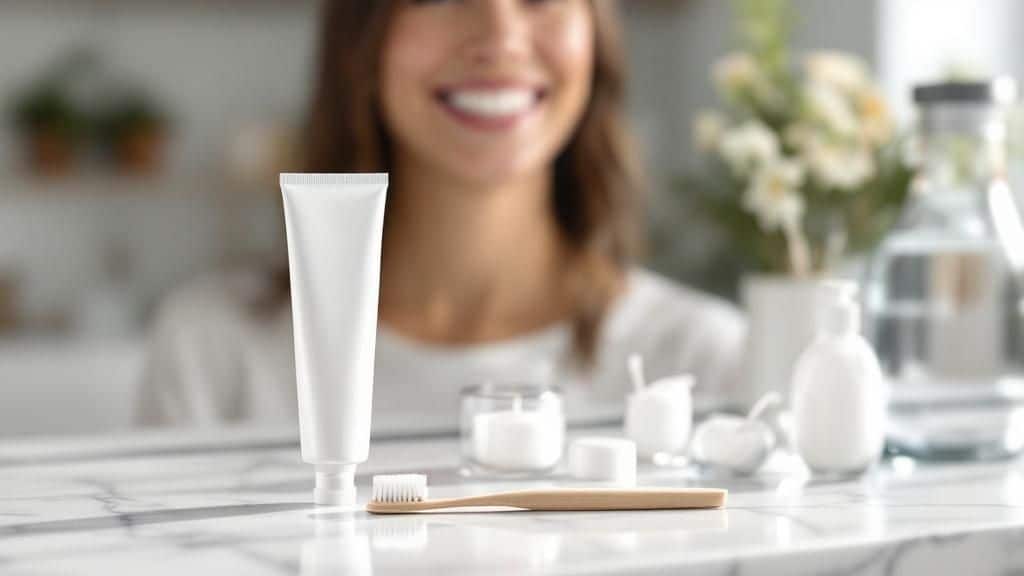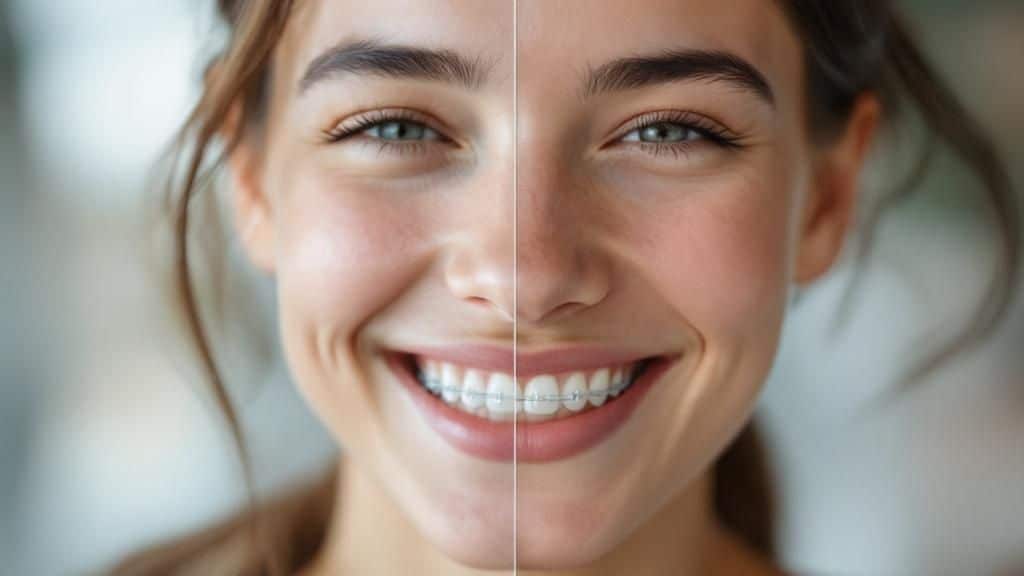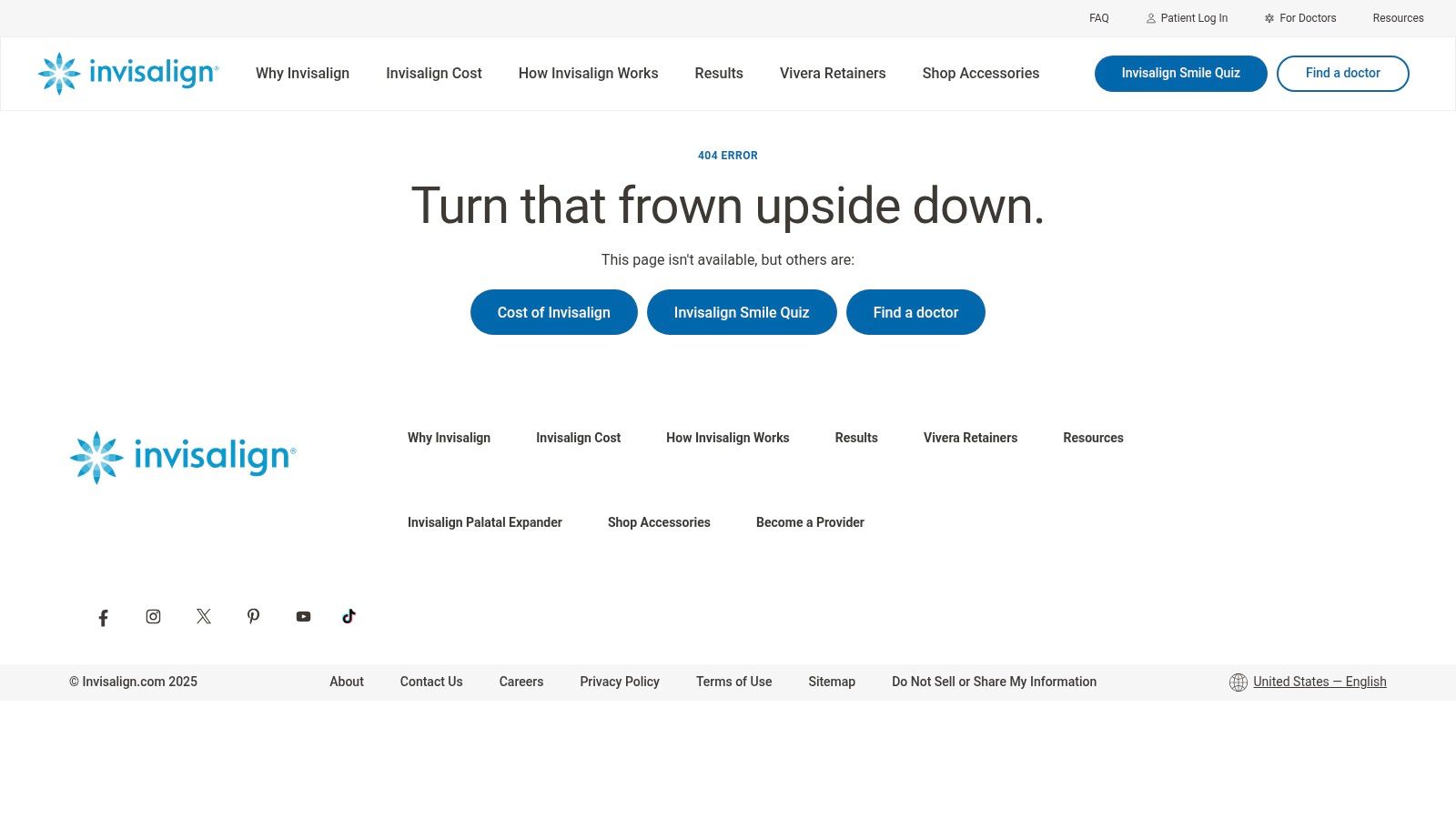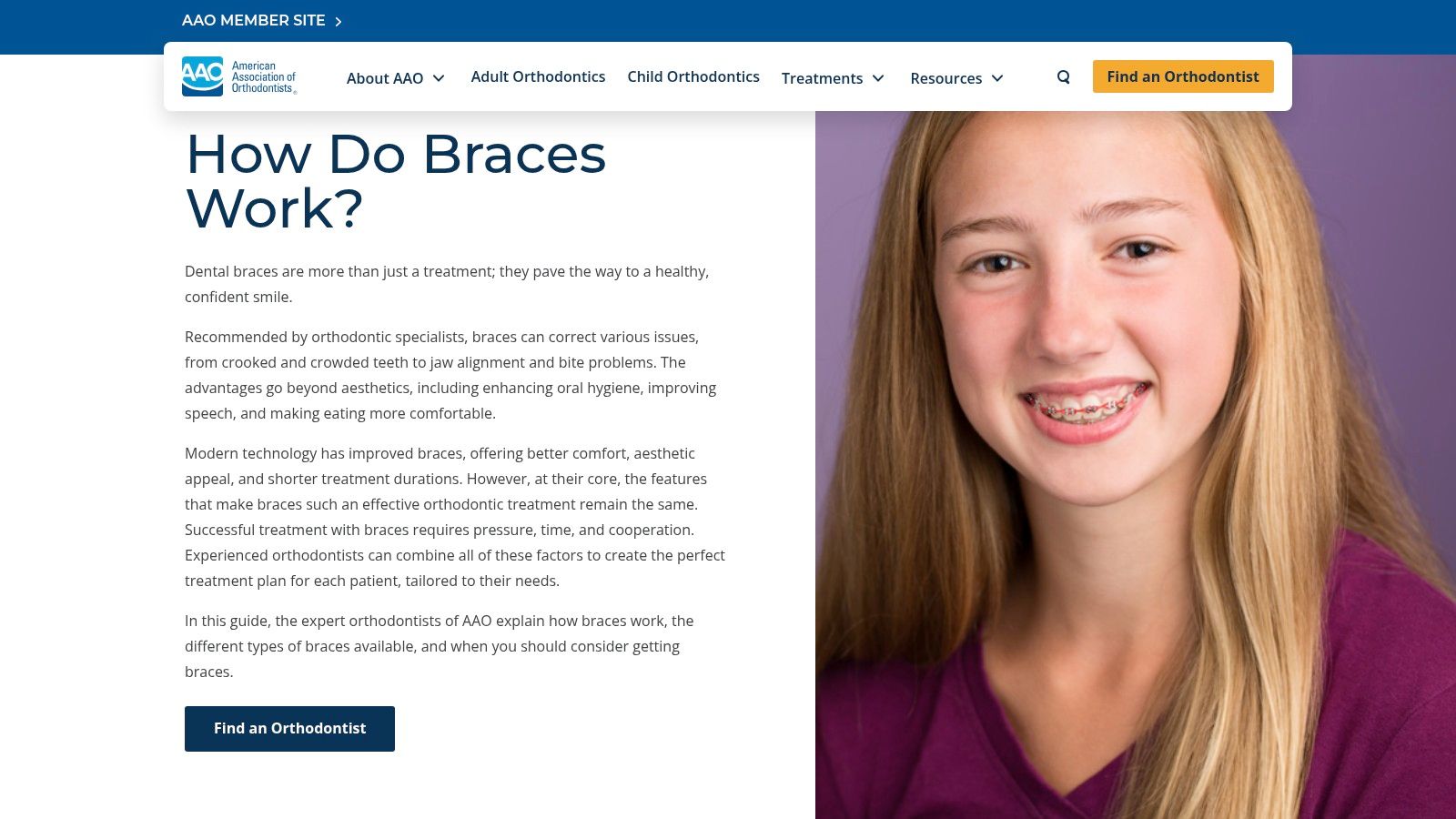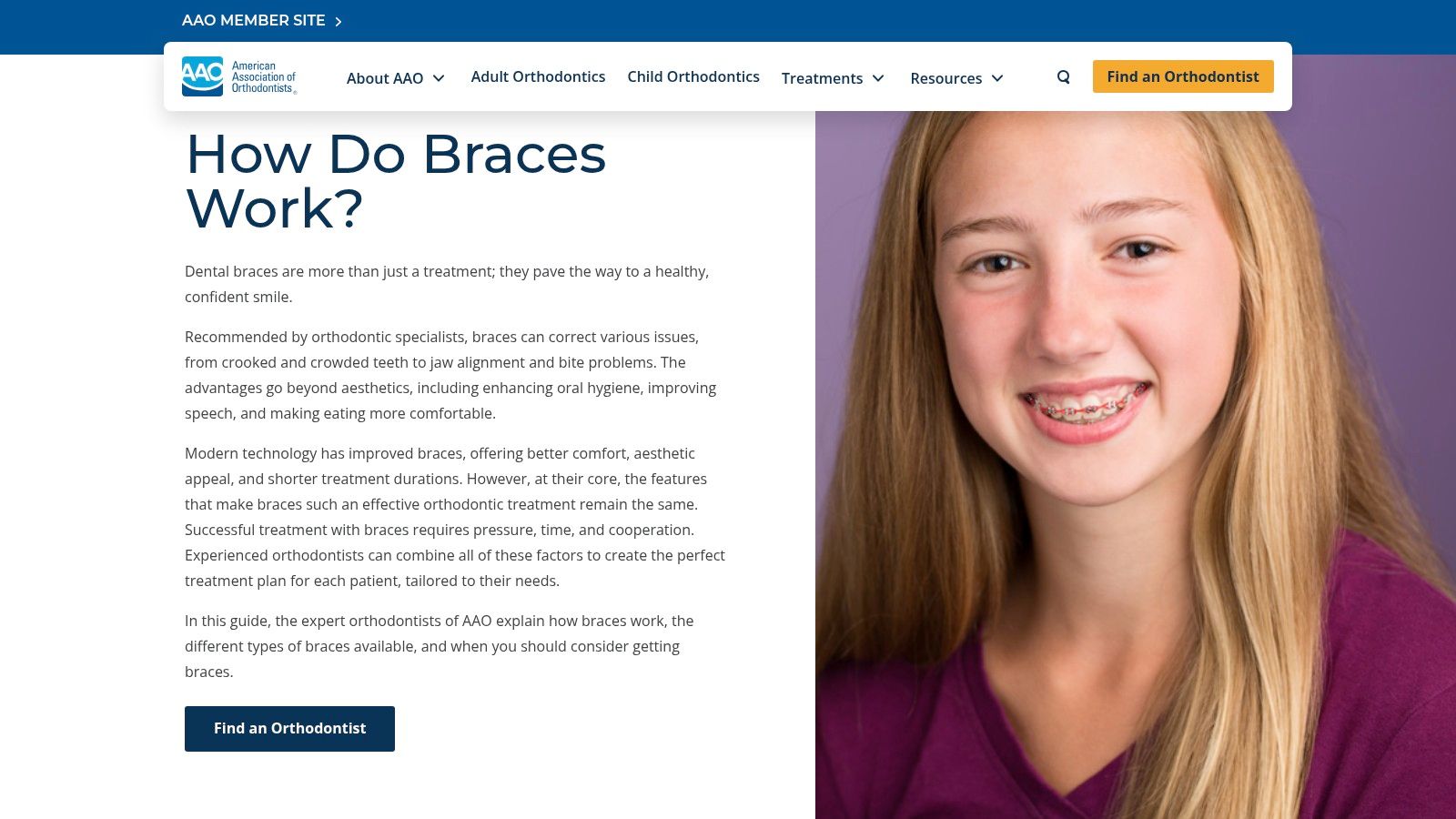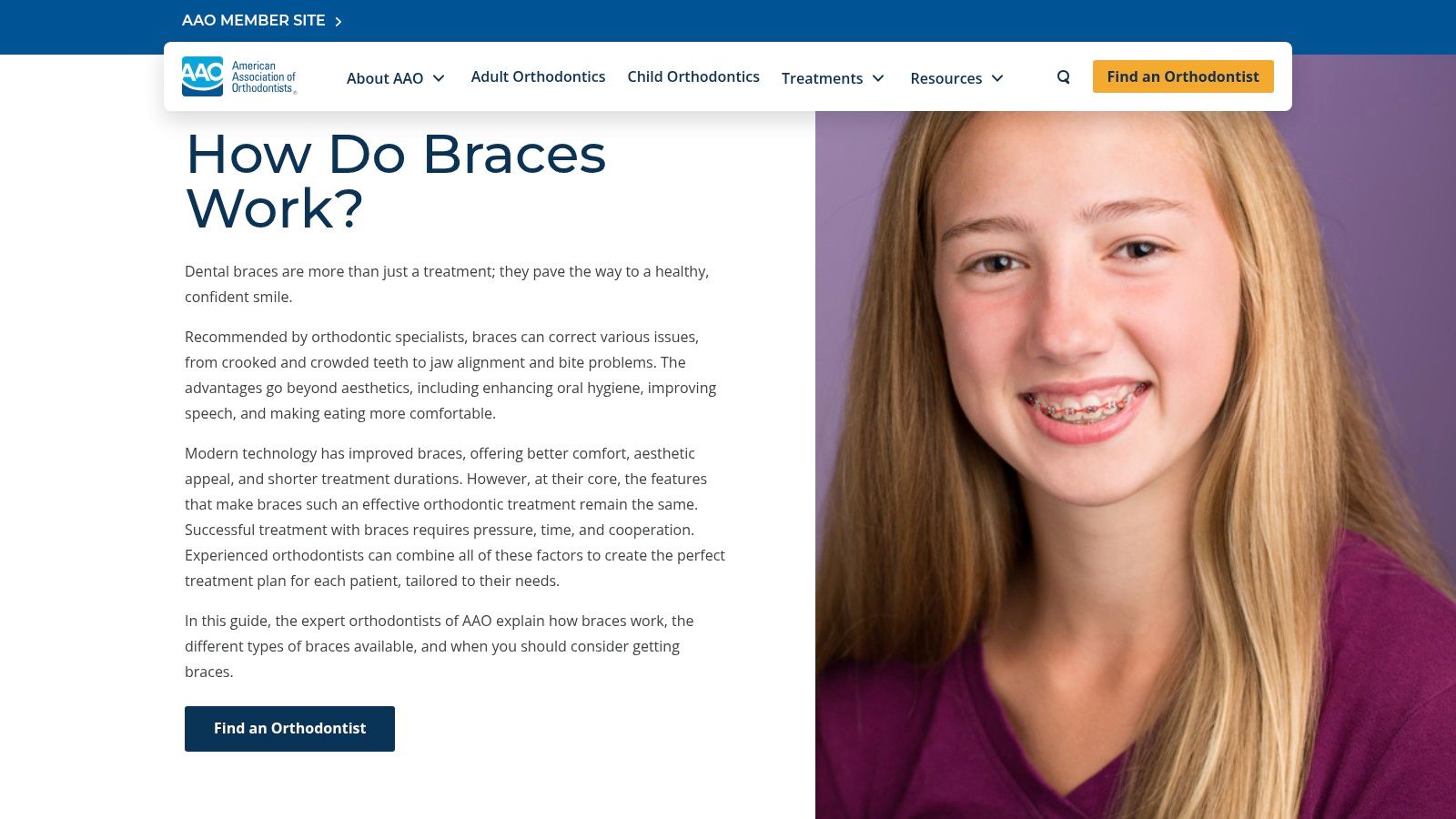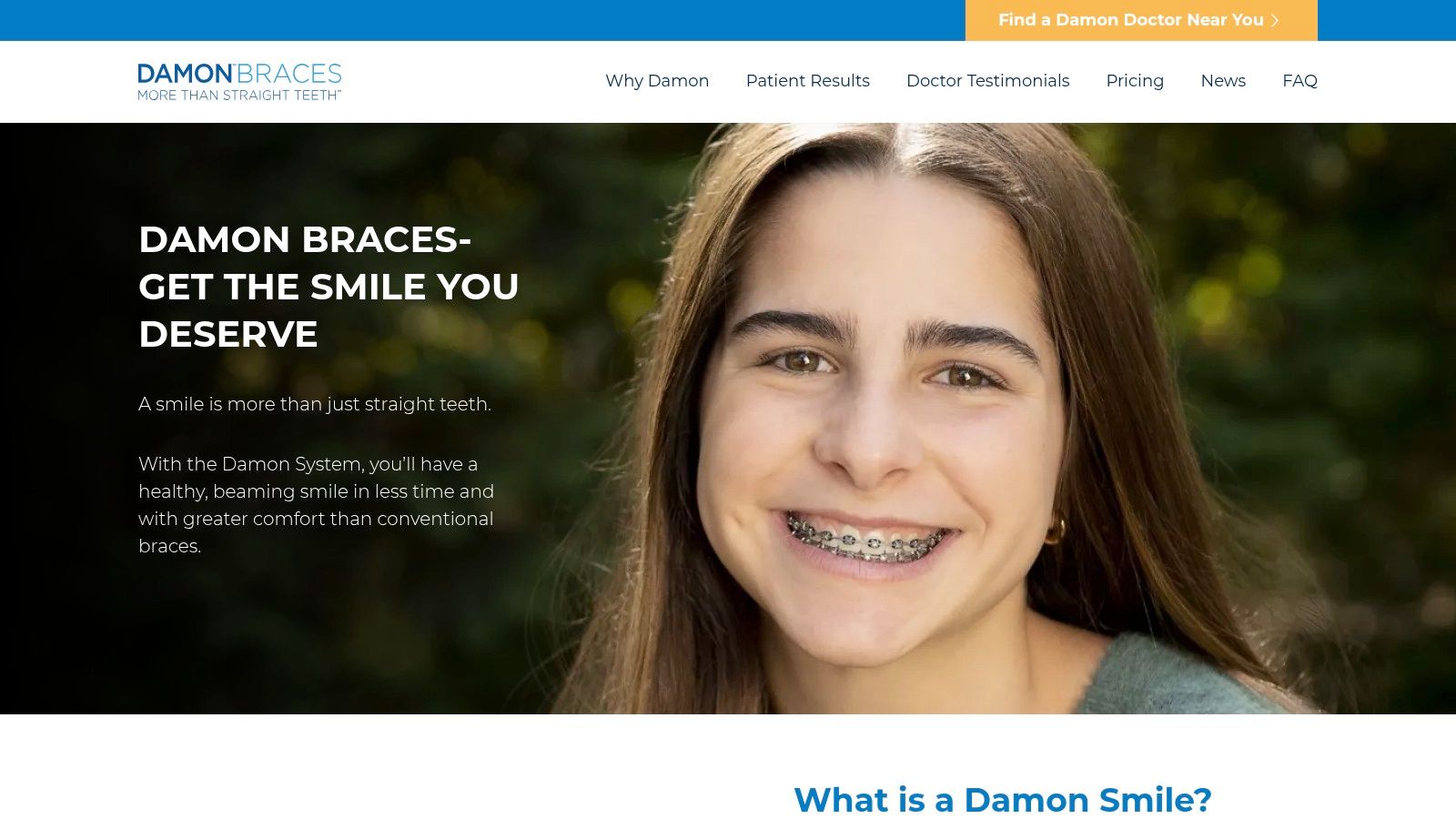Choosing the Right Orthodontic Treatment for Your Child
Is your child ready for orthodontic treatment? Choosing between Invisalign vs braces for kids can feel daunting. This guide simplifies the decision-making process by comparing five popular options: Invisalign First, traditional metal braces, ceramic braces, lingual braces, and self-ligating (Damon System) braces. We'll cover the key features of each treatment to help you determine the best fit for your child's needs and lifestyle in Maidstone and Rochester. Let's make finding the perfect path to a healthy, confident smile easier!
1. Invisalign First
Invisalign First is a specialized orthodontic treatment designed for younger children aged 6-10 who are in the mixed dentition phase, meaning they have a combination of baby and permanent teeth. This makes it a key contender in the Invisalign vs braces for kids debate. Unlike traditional braces, Invisalign First uses a series of clear, removable aligners to gradually shift teeth into their correct positions. These aligners are custom-made using Invisalign's patented SmartTrack material, which is comfortable to wear and provides predictable tooth movement. This system is designed to not only address existing alignment issues but also to accommodate the eruption of permanent teeth, making it a proactive approach to orthodontic care in growing children. For parents in Maidstone and Rochester seeking a modern orthodontic solution for their children, Invisalign First offers a compelling alternative to traditional metal braces.
One of the standout features of Invisalign First is its use of SmartTrack material. This innovative material allows for more controlled and gentle tooth movement, reducing discomfort often associated with traditional braces. The aligners also incorporate built-in compliance indicators that fade over time, helping parents and dentists monitor the child's wear time. Ensuring consistent wear – typically 20-22 hours per day – is crucial for successful treatment.
Invisalign First also addresses the unique needs of growing children with features like eruption tabs. These tabs are strategically placed within the aligners to create space for incoming permanent teeth and guide them into proper alignment. Precision Wings, another innovative feature, help correct bite issues and promote proper jaw development. The entire treatment process is planned using ClinCheck software, a 3D modelling tool that allows dentists to visualize the predicted tooth movement and create a personalized treatment plan for each child. This level of customization ensures optimal results and allows parents to see the projected outcome of their child's treatment.
Compared to traditional braces, Invisalign First offers several advantages, particularly for image-conscious children. The near-invisibility of the aligners boosts a child's confidence and eliminates the potential for teasing or self-consciousness sometimes associated with metal braces. The removability of the aligners is another significant benefit. Children can easily remove the aligners for eating, brushing, and flossing, making it easier to maintain good oral hygiene during treatment and reducing the risk of plaque buildup and cavities. This also allows children to participate in sports and musical activities without the restrictions of fixed braces. For patients in Maidstone and Rochester who value comfort and convenience, Invisalign First provides a more user-friendly orthodontic experience.
However, Invisalign First is not without its drawbacks. It requires significant discipline from the child to wear the aligners for the recommended 20-22 hours per day. Younger children may need parental supervision and reminders to ensure compliance. Cost is another factor to consider. Invisalign First is typically more expensive than traditional braces, ranging from £3,000 to £7,000 in the UK, depending on the complexity of the case and the length of treatment. It's important to discuss financing options with your dental provider. Denplan, for example, may offer payment plans that make Invisalign First more accessible.
Furthermore, Invisalign First is not suitable for all orthodontic cases. It is generally recommended for mild to moderate alignment issues and is not effective for correcting severe malocclusions or skeletal discrepancies. A consultation with a qualified orthodontist is essential to determine if Invisalign First is the right treatment option for your child. Finally, the aligners can be easily lost or damaged, especially with younger children. Replacement aligners can be costly and delay treatment progress, so careful handling and storage are crucial.
For families in Maidstone and Rochester considering Invisalign vs braces for kids, Invisalign First offers a discreet, comfortable, and convenient alternative for younger patients. The benefits of improved aesthetics, removability, and ease of oral hygiene make it an attractive option. However, the cost, the need for patient compliance, and the suitability for only certain cases are important factors to consider. Visiting a trusted dental provider for a thorough evaluation and discussion of treatment options is the best way to make an informed decision. You can find more information on Invisalign First on their website: https://www.invisalign.com/treatment-options/invisalign-first
2. Traditional Metal Braces
Traditional metal braces have long been the cornerstone of orthodontic treatment for children and remain a highly effective solution for achieving a straight, healthy smile. When considering Invisalign vs braces for kids, metal braces often stand out as the most versatile and reliable option, especially for complex cases. They consist of small metal brackets bonded directly to each tooth, connected by archwires that exert gentle, continuous pressure to guide teeth into their desired positions. While the fundamental principles remain the same, advancements in materials and technology have led to smaller, more comfortable, and more efficient braces than ever before. This makes them an excellent choice for correcting a wide range of orthodontic issues in children, from simple crowding to more complex bite problems. For families in Maidstone and Rochester seeking a trusted dental provider for their children's orthodontic needs, understanding the benefits and drawbacks of traditional braces is crucial.
Traditional metal braces offer a range of features that contribute to their effectiveness. They typically utilize high-grade stainless steel brackets and wires, ensuring durability and resilience throughout the treatment process. Self-ligating braces, a newer variation, are also available and offer reduced friction, potentially leading to faster treatment times and fewer adjustments. One appealing aspect for children is the option to personalize their braces with colourful elastic bands, adding a touch of fun to the experience. Most importantly, traditional metal braces are backed by decades of research and clinical experience, providing a proven track record of success. They are also compatible with other orthodontic appliances, offering flexibility in addressing complex cases. This established technology makes them a reliable choice for parents in the Maidstone and Rochester areas who are considering Invisalign vs braces for kids.
One of the most significant advantages of metal braces is their cost-effectiveness. Typically ranging from £2,500 to £6,000 in the UK, they represent the most affordable option compared to other orthodontic treatments like Invisalign. This affordability makes them accessible to a broader range of families. Another crucial benefit is their suitability for virtually all types of orthodontic problems. Unlike Invisalign, which might not be effective for severe malocclusions, metal braces can effectively address even the most complex cases. Because they are fixed to the teeth, they cannot be lost or forgotten like removable aligners, ensuring consistent treatment progress. This is particularly important for children who may not be as diligent with compliance. For families in Maidstone and Rochester, this reliability is a key factor when choosing between Invisalign vs braces for kids.
While traditional metal braces are highly effective, they do come with some drawbacks. The most obvious is their visible metallic appearance, which can be a concern for some children, especially teenagers. There are also certain food restrictions, such as avoiding sticky or hard foods, to prevent damage to the brackets and wires. Maintaining good oral hygiene can also be more challenging with braces, requiring meticulous brushing and flossing techniques. Initially, there may be some discomfort and potential for mouth sores as the braces adapt to the mouth. However, modern orthodontic techniques and materials have minimized these issues significantly.
For families in Maidstone and Rochester considering Invisalign vs braces for kids, traditional metal braces represent a proven, versatile, and cost-effective solution. Their ability to address a wide range of orthodontic problems, combined with their fixed nature and affordability, makes them a compelling choice. While there are aesthetic and lifestyle considerations, the long-term benefits of a healthy, straight smile often outweigh these temporary inconveniences. You can learn more about braces from the American Association of Orthodontists website: https://www.aaoinfo.org/what-we-do/public-awareness/braces. Discussing the options with a qualified orthodontist in your area is essential to determine the best course of treatment for your child's specific needs.
3. Ceramic Braces
When weighing up Invisalign vs braces for kids, ceramic braces offer a compelling middle ground, combining the effectiveness of traditional braces with a more discreet appearance. They operate on the same principle as metal braces, applying gentle pressure to gradually shift teeth into their desired positions. However, instead of metal brackets, ceramic braces utilize brackets made from polycrystalline alumina, a strong yet translucent material that blends in with the natural colour of teeth. This makes them a particularly attractive option for image-conscious children and teenagers in Maidstone and Rochester who desire effective orthodontic treatment without the prominent metalwork. Families seeking a balance between aesthetics and functionality often find ceramic braces to be a suitable solution.
Ceramic braces, much like their metal counterparts, are compatible with all standard orthodontic techniques, addressing a wide range of malocclusions (bite problems). Whether your child needs corrections for overbites, underbites, crowding, or spacing issues, ceramic braces can deliver the desired results. They are available with either white or clear elastic ties, further enhancing their discreet appearance. The stain-resistant ceramic material helps maintain their aesthetic appeal throughout the treatment duration, although the elastic ties can be prone to staining from certain foods and drinks. Regular adjustments by your orthodontist in Maidstone or Rochester will ensure the braces continue to apply the correct pressure for optimal tooth movement.
For families in Maidstone and Rochester considering Invisalign vs braces for kids, the cost is often a key factor. Ceramic braces typically fall within the £2,500-£6,000 price range in the UK, placing them above metal braces in terms of cost but generally below Invisalign. This positions them as a mid-range option, providing an aesthetic upgrade from metal braces without the higher price tag of clear aligners. It's important to discuss financing options with your dental provider, such as Denplan, which can help spread the cost of treatment into manageable monthly payments.
While ceramic braces offer a compelling blend of aesthetics and functionality, they also have some drawbacks to consider. The brackets, while less visible than metal, are slightly larger than metal alternatives. This can sometimes cause minor discomfort, especially during the initial adjustment period. Additionally, the ceramic material, although strong, is more susceptible to chipping or breakage compared to metal brackets. Patients wearing ceramic braces need to be mindful of biting into hard foods or engaging in contact sports, which could potentially damage the brackets. Good oral hygiene practices are crucial to prevent staining of the elastic ties and maintain the overall health of the teeth and gums throughout the treatment.
Key Features of Ceramic Braces:
- Tooth-coloured or clear ceramic brackets: Offer a discreet appearance.
- Same mechanical function as metal braces: Effective for all types of orthodontic issues.
- Available with white or clear elastic ties: Further enhances aesthetics.
- Stain-resistant ceramic material: Helps maintain a clean look.
- Compatible with all orthodontic techniques: Suitable for a wide range of cases.
Pros of Ceramic Braces:
- Much less visible than metal braces: Boosts confidence for image-conscious children.
- Effective for all orthodontic problems: Provides comprehensive treatment.
- Same treatment efficiency as metal braces: Achieves desired results within a similar timeframe.
- Good compromise between aesthetics and function: Balances appearance and effectiveness.
Cons of Ceramic Braces:
- More expensive than metal braces (£2,500-£6,000): Represents a higher initial investment.
- Larger bracket size than metal alternatives: Can cause slight discomfort initially.
- Elastic ties can stain with certain foods: Requires careful attention to diet.
- Brackets may chip or break more easily than metal: Demands extra care during treatment.
For more detailed information on braces, you can visit the American Association of Orthodontists website: https://www.aaoinfo.org/what-we-do/public-awareness/braces
When choosing between Invisalign vs braces for kids in Maidstone and Rochester, discussing the options thoroughly with a qualified orthodontist is vital. They can assess your child's specific needs and recommend the most suitable treatment approach. Ceramic braces represent a valuable option for those seeking a blend of discreet aesthetics and proven orthodontic efficacy.
4. Lingual Braces
Lingual braces offer a unique approach to orthodontic treatment, particularly appealing to image-conscious children and teenagers in the UK. Unlike traditional braces that are fixed to the front of the teeth, lingual braces are attached to the back, making them virtually invisible. This discreet nature makes them a compelling alternative for young patients seeking orthodontic correction without the aesthetic concerns associated with conventional braces. When considering Invisalign vs braces for kids, lingual braces offer a fixed appliance option with the benefit of invisibility. This is particularly relevant in areas like Maidstone and Rochester, where families are seeking modern and discreet orthodontic solutions for their children.
While both Invisalign and traditional braces are common choices, lingual braces provide a unique advantage for those prioritizing aesthetics. For children involved in sports, lingual braces eliminate the risk of bracket damage that can occur with traditional braces. Moreover, unlike Invisalign which requires patient compliance for effective treatment, lingual braces offer a fixed solution, ensuring consistent force application for predictable results. This can be particularly advantageous for younger children who might struggle with the responsibility of wearing removable aligners consistently.
Lingual braces are custom-made for each patient using advanced 3D treatment planning. This tailored approach ensures a precise fit and allows orthodontists to plan complex tooth movements with accuracy. Specialized archwires, designed specifically for lingual placement, are used in conjunction with custom-manufactured brackets. This bespoke system allows for comprehensive orthodontic treatment, addressing a wide range of malocclusions effectively. The technology behind lingual braces offers a level of precision comparable to, and sometimes exceeding, that of traditional braces.
However, this advanced technology and customized approach come at a cost. Lingual braces are typically the most expensive option among orthodontic treatments, ranging from £8,000 to £13,000 in the UK. This higher price point reflects the specialized training required for orthodontists to install and adjust lingual braces, as well as the intricate manufacturing process involved in creating the custom brackets and archwires. Families in Maidstone and Rochester considering lingual braces should factor this cost into their decision-making process and explore available finance options, such as Denplan, to manage the expense.
Another potential drawback is the initial adjustment period. The placement of brackets on the tongue-side of the teeth can cause temporary speech impediments and tongue irritation. Patients typically adapt to the presence of the braces over time, but the initial discomfort can be a consideration, especially for younger children. Furthermore, maintaining oral hygiene with lingual braces can be more challenging compared to traditional braces or Invisalign. Special cleaning tools and techniques are often required to effectively clean the brackets and wires behind the teeth. This requires diligent effort from the patient and guidance from the orthodontist to prevent plaque buildup and maintain optimal oral health throughout the treatment duration.
Finally, treatment time with lingual braces can sometimes be longer than with traditional braces, and adjustments can be more complex due to the unique placement of the brackets. This necessitates more frequent visits to the orthodontist and requires a higher level of expertise from the practitioner. Despite these challenges, the discreet nature and effectiveness of lingual braces make them a viable option for children seeking comprehensive orthodontic treatment with minimal aesthetic impact. For families in Maidstone and Rochester seeking a trusted dental provider offering lingual braces, it's crucial to find an experienced orthodontist with a proven track record in this specialized treatment modality. More information on braces can be found at the American Association of Orthodontists website: https://www.aaoinfo.org/what-we-do/public-awareness/braces.
5. Self-Ligating Braces (Damon System)
When weighing up Invisalign vs braces for kids, self-ligating braces, particularly the Damon System, offer a compelling alternative to traditional metal braces. They address some of the drawbacks of conventional braces, making them a popular choice for both children and adults. This system employs a unique mechanism that distinguishes it from traditional braces and offers several potential advantages for younger patients undergoing orthodontic treatment. While traditional braces rely on elastic ties to hold the archwire in place, the Damon System utilises a slide mechanism within the bracket itself. This seemingly small difference has a significant impact on the overall treatment experience.
The Damon System’s defining feature is its self-ligating brackets. These brackets have a small, built-in door or clip that secures the archwire, eliminating the need for elastic ties. This tie-less design reduces friction between the archwire and the bracket, allowing teeth to move more freely and naturally. For children in Maidstone and Rochester, this can mean a more comfortable orthodontic journey. The reduced friction translates to less pressure on the teeth, potentially minimizing discomfort often associated with traditional braces. Furthermore, the absence of elastic ties makes Damon braces significantly easier to clean, promoting better oral hygiene during treatment – a crucial factor for kids. Food particles are less likely to get trapped, reducing the risk of plaque buildup and potential complications. This is particularly beneficial for younger patients who might not be as diligent with their oral hygiene routine.
For families considering Invisalign vs braces for kids in the UK, treatment time is a key consideration. The Damon System often boasts faster treatment times compared to traditional braces, sometimes up to six months shorter. This quicker treatment duration is attributed to the low-friction, low-force approach of the self-ligating system. Fewer adjustments are typically required, meaning fewer visits to the orthodontist in Maidstone and Rochester. This can be a significant advantage for busy families and children with packed schedules.
The Damon System is available in both metal and clear ceramic options. While the metal option provides a robust and cost-effective solution, the clear ceramic option offers a more aesthetically pleasing alternative, blending in with the natural tooth colour. This is particularly relevant for image-conscious teenagers.
However, it’s important to consider the cons. Damon braces, despite their advantages, come at a higher cost than traditional metal braces, typically ranging from £3,500 to £8,000 in the UK. While the Damon System claims several benefits, the long-term advantages compared to traditional braces are still under research. It’s also worth noting that not all orthodontists are trained in the Damon System, so finding a qualified provider in Maidstone or Rochester might require some research. You can find more information on their website: https://www.damonbraces.com/.
For families in Maidstone and Rochester, the Damon System represents a viable option in the Invisalign vs braces for kids debate. Its unique features address some of the key concerns associated with traditional braces, offering potential benefits in terms of comfort, treatment duration, and ease of cleaning. However, the higher cost and limited availability of trained orthodontists are important factors to consider when making a decision. Consulting with a qualified orthodontist is crucial to determine the most suitable treatment option for your child's individual needs and circumstances. They can assess your child's dental development, discuss the pros and cons of each option (including Invisalign), and recommend the best course of action for achieving a healthy and beautiful smile.
Orthodontic Options Comparison for Kids
| Orthodontic Option | Core Features/Technology | User Experience/Quality ★★★★☆ | Value Proposition 💰 | Target Audience 👥 | Unique Selling Points ✨ |
|---|---|---|---|---|---|
| Invisalign First | SmartTrack material, compliance indicators, eruption tabs, Precision Wings, 3D planning | Comfortable, nearly invisible, easy hygiene | $$ ($3,000-$7,000) | Children 6-10 | Removable, built-in compliance, gentle tooth movement 🏆 |
| Traditional Metal Braces | Stainless steel brackets, self-ligating options, proven tech, customizable elastics | Effective, fastest for complex cases | $ ($2,500-$6,000) | All pediatric orthodontic cases | Cost-effective, robust, no risk of loss 🏆 |
| Ceramic Braces | Tooth-colored ceramic brackets, stain-resistant, clear elastics | Less visible, same efficiency as metal | $$ ($3,000-$7,000) | Image-conscious kids/teens | Aesthetic compromise between metal and clear braces ✨ |
| Lingual Braces | Custom brackets behind teeth, advanced 3D planning | Invisible, complex case effective | $$$$ ($8,000-$13,000) | Discreet treatment seekers | 100% invisible, no external damage risk ✨ |
| Self-Ligating Braces (Damon System) | Built-in clips replace elastics, low friction, metal & ceramic options | Faster, fewer visits, comfortable | $$$ ($3,500-$8,000) | Patients seeking quicker treatment | Reduced pressure, easier cleaning, fewer appointments ✨ |
Making the Best Decision for Your Child's Smile
Choosing between Invisalign vs braces for kids is a significant decision. This article has explored several options, from Invisalign First for younger children to various types of braces, including traditional metal, ceramic, lingual, and self-ligating (Damon System) braces. Each option offers unique advantages and disadvantages in terms of appearance, comfort, cost, and treatment duration. Key takeaways include understanding the suitability of Invisalign First for phasing treatment, considering the discreet nature of ceramic or lingual braces, and appreciating the efficiency of self-ligating systems.
The best choice for your child depends on a combination of factors, such as their age, oral hygiene practices, the complexity of their orthodontic needs, and their personal preferences. For example, a teenager conscious about appearance might prefer Invisalign or ceramic braces, while a younger child with complex needs might benefit from traditional metal braces.
Implementing any of these tools requires commitment to maintaining good oral hygiene and attending regular check-ups. Effective communication with your orthodontist is also essential for a successful treatment outcome. In today's busy world, managing appointments and patient communication can be challenging. If you're looking for ways to streamline your practice's operations and improve the patient experience, an AI receptionist service could be a valuable addition. Source: Ai Vs Human from My AI Front Desk.
Ultimately, the goal is to create a healthy and confident smile for your child. Making an informed decision, in consultation with a qualified orthodontist, will set them on the path towards achieving this goal. To discuss the best orthodontic options for your child in Maidstone and Rochester, contact Smileology Dental Practice. Our experienced team specializes in creating personalized treatment plans, from Invisalign to traditional braces, to help your child achieve a smile they'll love. Visit Smileology Dental Practice to schedule a consultation.



